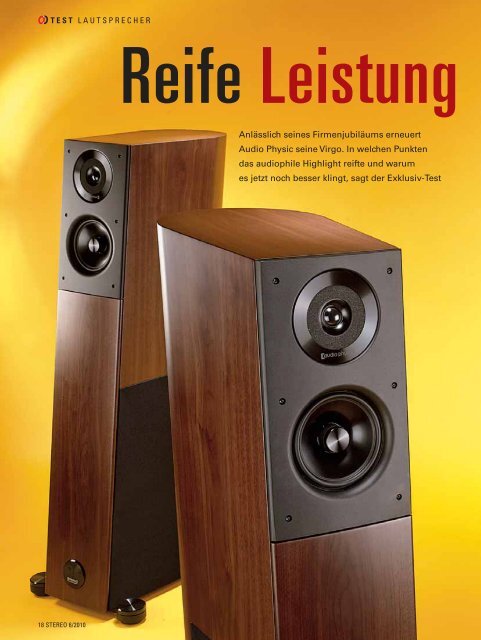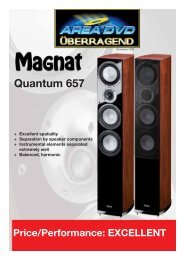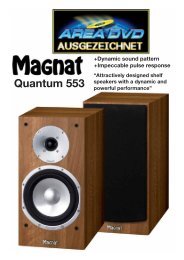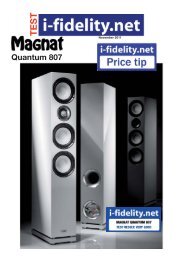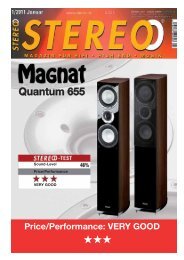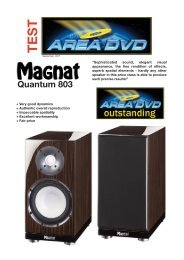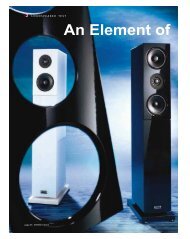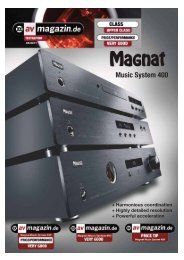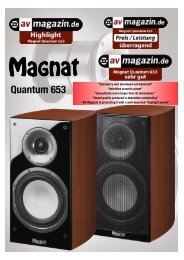Testbericht Deutsch und Englisch PDF 690 KB - Audio Physic
Testbericht Deutsch und Englisch PDF 690 KB - Audio Physic
Testbericht Deutsch und Englisch PDF 690 KB - Audio Physic
Create successful ePaper yourself
Turn your PDF publications into a flip-book with our unique Google optimized e-Paper software.
TEST LAUTSPRECHER<br />
Reife Leistung<br />
Anlässlich seines Firmenjubiläums erneuert<br />
<strong>Audio</strong> <strong>Physic</strong> seine Virgo. In welchen Punkten<br />
das audiophile Highlight reifte <strong>und</strong> warum<br />
es jetzt noch besser klingt, sagt der Exklusiv-Test<br />
18 STEREO 6/2010
von Matthias Böde<br />
Nur wer sich ändert, könne sich wirklich<br />
treu bleiben, heißt es. Weshalb<br />
das stimmt, demonstriert <strong>Audio</strong> <strong>Physic</strong>s<br />
pünktlich zum 25-jährigen Bestehen<br />
des Lautsprecherspezialisten aus Brilon<br />
r<strong>und</strong>erneuertes Erfolgsmodell Virgo.<br />
Nach der Tempo 25 (ab 3750 Euro<br />
das Paar, Test in STEREO 1/10) ist<br />
sie bereits die zweite Jubiläumsbox<br />
der Sauerländer. Doch während die in<br />
diesem Zuge vor allem mit einem hochwertigeren<br />
Tweeter aufgewertete Tempo erst<br />
auf den zweiten Blick als „25er“ erkennbar<br />
ist, hebt sich die neue Virgo in jeder Hinsicht<br />
deutlicher ab. Und anders als die normale<br />
Tempo, die zum Paarpreis von r<strong>und</strong><br />
3000 Euro im Programm bleibt, ist die bisherige,<br />
zirka 6000 Euro teure fünfte Variante<br />
der Virgo ab sofort Geschichte.<br />
Virgo legt in Preis <strong>und</strong> Größe zu<br />
So legt die Virgo 25 in Preis <strong>und</strong> Format zu:<br />
Sie kostet 1500 Euro pro Paar mehr <strong>und</strong><br />
wächst um gut fünf Zentimeter. Dafür ist sie<br />
allerdings ein Zentimeterchen weniger tief.<br />
Geblieben ist die Gr<strong>und</strong>form mit dem sich<br />
nach hinten verbreiternden,<br />
schwungvoll herumgezogenen<br />
Gehäuse <strong>und</strong> der schmalen, sich<br />
um exakt sieben Grad nach hinten<br />
neigenden Schallwand, die so<br />
auf elegante Weise den Ebenenversatz<br />
der am oberen Ende eingesetzten<br />
Mittel- <strong>und</strong> Hochtöner<br />
zu den beiden wie bisher seitlich<br />
montierten Basstreibern ausgleicht – wichtig<br />
fürs präzise Timing, also das gleichzeitige<br />
Eintreffen aller Frequenzen am Hörplatz.<br />
Wie bei <strong>Audio</strong> <strong>Physic</strong>s großer, ebenfalls<br />
neuer Cardeas (ab 18000 Euro/P.) sind die<br />
Frontchassis in eine solide, zentimeterdicke<br />
STICHWORT<br />
„SSC“-Aufhängung:<br />
Das „String Suspension<br />
Concept“ aus<br />
Kunstfasergewebe<br />
setzt Bewegungen in<br />
Zugenergie um <strong>und</strong><br />
unterbricht so Resonanzkreise.<br />
Aluplatte eingelassen, die Detailverluste aufgr<strong>und</strong><br />
unerwünschter Bewegungen verhindern<br />
soll. Denn dass der „Mechanik“ um die<br />
Töner herum großer Stellenwert zukommt,<br />
weiß Entwickler Manfred Diestertich nur zu<br />
genau. Aus diesem Gr<strong>und</strong> hat er den Tweeter<br />
zusätzlich in einem straff gespannten<br />
„SSC“-Netzgeflecht aufgehängt, sind dessen<br />
Kontaktstellen vom Korb entkoppelt <strong>und</strong><br />
sorgen Kunststoffschrauben in Neopren -<br />
dübeln für eine akustisch besonders vorteilhafte<br />
Chassisbefestigung, wie <strong>Audio</strong> <strong>Physic</strong><br />
in Hörvergleichen herausfand.<br />
Diese offenbarten auch die<br />
Vorzüge der teuren „Nextgen“-<br />
Anschlussklemmen des Essener<br />
Spezialisten WBT gegenüber<br />
simpleren Lösungen, weshalb sie<br />
hier Standard sind. Last not least<br />
bekam der Hochtöner einen besonders<br />
hochwertigen, mechanisch<br />
stabilen Folienkondensator<br />
vom britischen Anbieter ClarityCap, der<br />
am besten „klang“ <strong>und</strong> dessen lange Zuleitung<br />
unmittelbar mit den Pluspolen des Anschlussfelds<br />
<strong>und</strong> des Tweeters verb<strong>und</strong>en ist.<br />
Direkter <strong>und</strong> verlustärmer geht’s nicht. Lediglich<br />
ein paar direkt am Chassis sitzende<br />
Der „Hyper Holographic Cone Tweeter“<br />
besitzt ein Doppelkorb-System aus Metall<br />
<strong>und</strong> Kunststoff (siehe Schnittmodell links).<br />
Er wird speziell befestigt <strong>und</strong> entkoppelt (o.)<br />
Vorwiderstände zur Pegelanpassung sind<br />
dann noch im Signalweg.<br />
Natürlich macht der ganze Aufwand nur<br />
dann Sinn, wenn man bei den Treibern keine<br />
Kompromisse eingeht. Für die Mitten<br />
<strong>und</strong> Höhen kommen deshalb verfeinerte<br />
Exemplare der „Hyper Holographic Cones“<br />
zum Einsatz. Sie werden nach Diestertichs<br />
Vorgaben von Wavecor gefertigt, der noch<br />
jungen, gegenüber speziellen Wünschen aufgeschlossenen<br />
Unternehmung des ehemaligen<br />
Vifa-Entwicklungsleiters Allan Isaksen.<br />
Feinschliff an den Chassis<br />
Schon richtig: Der mit aufwändiger Doppelkorbkonstruktion<br />
ausgestattete „HHCT“<br />
(Tweeter) <strong>und</strong> „HHCM“ (Midrange), wobei<br />
sich Metall <strong>und</strong> Kunststoff resonanztechnisch<br />
raffiniert ergänzen, war auch in der<br />
bisherigen Virgo zu finden. Der Hochtöner<br />
wurde inzwischen jedoch modifiziert <strong>und</strong><br />
wird strenger selektiert. Bedeutender sind<br />
die Änderungen am Mittentreiber, der denen<br />
in der Cardeas entspricht. Sein optimiertes<br />
Magnetsystem bewegt einen mit verkupfertem<br />
Aluminiumdraht bewickelten<br />
Die Virgo-Evolution – Konstanz im Wandel<br />
Schmale Schallwand, seitliche Bässe – das Gr<strong>und</strong>konzept der Virgo ist seit ihrer<br />
Vorstellung 1990 dasselbe. Seitdem wurde der Lautsprecher – die Fotos zeigen die<br />
Versionen 2, 3 <strong>und</strong> 5 (v.l.n.r.) – immer wieder verändert, <strong>und</strong> blieb sich doch treu<br />
Diese Kondensatoren für die Frequenzweichen<br />
stammen vom britischen Hersteller ClarityCap <strong>und</strong><br />
sind Sondermodelle für <strong>Audio</strong> <strong>Physic</strong><br />
6/2010 STEREO 19
TEST LAUTSPRECHER<br />
Schwingspulenträger aus<br />
einem glasfaserverstärkten<br />
Kunststoff, der gegen -<br />
über dem alten Aluteil<br />
Wirbelströme <strong>und</strong> damit<br />
jede „magnetische Bremse“<br />
vermeidet.<br />
Ihnen schwirrt schon<br />
der Kopf vor lauter Technik?<br />
Sorry, aber ohne diese<br />
Hintergründe versteht<br />
man kaum, wie viel Detailarbeit<br />
in der neuen Virgo steckt.<br />
Und die war notwendig, schließlich<br />
galt es, das bisherige, hervorragende<br />
Modell nicht nur graduell,<br />
sondern möglichst deutlich<br />
zu übertreffen. Um das zu<br />
überprüfen, mussten wir gar<br />
nicht lange suchen, denn die bisherige<br />
Virgo gehört zu unseren<br />
beliebtesten Arbeitslautsprechern.<br />
Sie spielt klar <strong>und</strong> schlackelos,<br />
löst erstklassig auf <strong>und</strong> liefert tatsächlich<br />
das von den „Hyper Holographic<br />
Cones“ versprochene dreidimensionale,<br />
plastische Klangbild.<br />
Und doch bleibt sie deutlich hinter der<br />
Virgo 25 zurück. Hatten wir bereits dem alten<br />
Modell eine vorzügliche Mittenwiedergabe<br />
bescheinigt, so addiert die Nachfolgerin<br />
zur Klarheit noch eine bislang ungekannte<br />
natürliche Süße. Keine artifizielle<br />
Das Single-Wire-<br />
Terminal ist mit<br />
WBTs „Nextgen“-<br />
Buchsen bestückt.<br />
Statt Spikes sollte<br />
man <strong>Audio</strong> <strong>Physic</strong>s<br />
„VCF“-Füße (um 240<br />
Euro/acht Stück)<br />
montieren, die eine<br />
bessere Räumlichkeit<br />
<strong>und</strong> Homogenität<br />
bewirken<br />
20 STEREO 6/2010<br />
Für den Mittel- <strong>und</strong> den<br />
Hochtöner gibt’s je eine<br />
separate Kammer, um sie<br />
vor den Druckwellen der<br />
Basschassis zu schützen.<br />
Ein Teil der Weiche belegt<br />
das vordere Abteil unten<br />
STICHWORT<br />
„VCF“-Füße:<br />
Auch <strong>Audio</strong> <strong>Physic</strong>s<br />
„Vibration Control<br />
Feet“ basieren auf<br />
dem SSC-Prinzip. Sie<br />
sind Spikes klanglich<br />
klar überlegen.<br />
Aufdickung, sondern eine angenehm <strong>und</strong><br />
absolut echt wirkende Sonorität,<br />
die das Timbre der<br />
Vorgängerin kühler, technischer,<br />
ja fast ein wenig<br />
streng erscheinen lässt. So<br />
tönt etwa Esther Fellners<br />
markante Stimme von der<br />
STEREO Hörtest-CD VI<br />
nun körperhafter, sie findet<br />
einen geschmeidigeren<br />
Anschluss an den Gr<strong>und</strong>tonbereich<br />
<strong>und</strong> besitzt dadurch<br />
mehr Kraft, Farbe<br />
<strong>und</strong> Eindringlichkeit.<br />
Überhaupt gewinnt die Virgo 25 in den<br />
unteren Lagen an Potenz, bleibt dabei aber<br />
locker, konturiert <strong>und</strong> unangestrengt. Keine<br />
Spur von Trägheit oder Schwammigkeit,<br />
die im Bass überzüchtete Lautsprecher verraten.<br />
Die tiefe Abstimmung kostet keine<br />
Kompromisse – nichtmal bei der Pegelfestigkeit.<br />
Unser Messtechniker<br />
wollte kaum glauben, was die<br />
beiden über eine Reflexöffnung<br />
im Boden der Box beatmeten<br />
13er-Woofer leisten: An der unteren<br />
Messgrenze von 20 Hertz<br />
waren sie noch voll da (siehe Frequenz<br />
gang). Das alte, sogar etwas<br />
unempfindlichere Modell<br />
erreichte seinen Minus-Drei-Dezibel-Punkt<br />
bereits bei 60 Hertz. Logisch, dass es da<br />
schwachbrüs tiger <strong>und</strong> in großorchestralen<br />
Bögen kurzatmiger wirkt.<br />
Highlight der audiophilen Klasse<br />
Gleichzeitig gelingt der neuen Virgo der<br />
Spagat, auch ihre analytischen Fähigkeiten<br />
auszubauen. Das leise sich unterhaltende<br />
Publikum in Red Norvos vor Details sprühendem<br />
Live-Titel „Saturday Night“ wird<br />
von der 25er noch stärker differenziert <strong>und</strong><br />
in der Tiefe weiter von der im Vordergr<strong>und</strong><br />
agierenden Band abgesetzt. Wie schon bei<br />
der kleineren Tempo 25 geschieht das alles<br />
ohne künstliche Aufhellungen. Ja, der<br />
hauchzart auflösende „Hyper“-Hochtöner<br />
ist eigentlich gar nicht zu hören. Will heißen,<br />
er hat keine auch nur ansatzweise auffällige<br />
Charakteristik.<br />
Damit lässt die Virgo 25 das alte Modell<br />
weit hinter sich. Die 1500 Euro Aufpreis erscheinen<br />
uns deshalb vollauf gerechtfertigt.<br />
Die Klasse der audiophilen Top-Boxen ist<br />
mit der neuen <strong>Audio</strong> <strong>Physic</strong> um ein Highlight<br />
reicher. In dieser Liga den Ton mit anzugeben,<br />
war der Anspruch jeder Virgo.<br />
Durch die aktuellen Veränderungen wird er<br />
abermals eingelöst. So bleibt sie sich treu.<br />
AUDIO PHYSIC VIRGO 25<br />
Paar ab €7500 (vier Furniere)<br />
Maße: 23 x105 x 38 cm (BxHxT)<br />
Garantie: 10 Jahre<br />
Vertrieb: <strong>Audio</strong> <strong>Physic</strong><br />
Tel.: 02961/96170<br />
www.audiophysic.de<br />
Diese Box ist nicht nur aufgr<strong>und</strong> ihrer<br />
Basspotenz eine Wucht! Als 25er spielt<br />
die Virgo erheblich ausgewogener <strong>und</strong><br />
reifer als ihre Vorgängerin <strong>und</strong> erreicht<br />
so eine neue Klasse. Ihr Mittenbereich<br />
ist ein Gedicht. R<strong>und</strong>um superb!<br />
MESSERGEBNISSE *<br />
Sprungantwort<br />
Nennimpedanz<br />
4 Ω<br />
minimale Impedanz<br />
3,3 Ω bei 453 Hertz<br />
maximale Impedanz<br />
22,9 Ω bei 48 Hertz<br />
mittlere Empfindlichkeit (2,83 V/m) 87,1 dB SPL<br />
Leistung für 94 dB (1m)<br />
6,57 W<br />
untere Grenzfrequenz (-3 dB)<br />
18 Hertz<br />
LABOR-KOMMENTAR<br />
Sehr linearer, für die Gehäusegröße extrem<br />
tief hinabreichender Frequenzgang. Der steile<br />
Höhenanstieg oberhalb von 16 Kilohertz<br />
spielt akustisch keine Rolle. Auch deshalb<br />
nicht, weil die 30-Grad-Messung zeigt, dass<br />
er nur direkt auf Achse zu einer Überhöhung<br />
führt. Der Impedanzverlauf ist ausgewogen.<br />
Dass um 450 Hertz herum die Vier-Ohm-Mar -<br />
ke knapp unterschritten wird, sollte keinen<br />
Verstärker stören. Gute Sprungantwort: Der<br />
Hoch- <strong>und</strong> der bis in den Oberbass übertragende<br />
Mitteltöner arbeiten fast zeitgleich.<br />
KLANG-NIVEAU 86 %<br />
PREIS/LEISTUNG<br />
EXZELLENT<br />
* Zusätzliche Messwerte <strong>und</strong> Diagramme für Abonnenten<br />
im STEREO-Club unter www.stereo.de
L O U D S P E A K E R T E S T<br />
Mature<br />
Performance<br />
On the occasion of its company anniversary, <strong>Audio</strong> <strong>Physic</strong><br />
has revamped its Virgo loudspeaker. Our exclusive test reveals<br />
the improvements that have matured this audiophile highlight<br />
and explains why it now produces an even better so<strong>und</strong>.<br />
18 STEREO 6/2010
y Matthias Böde<br />
I<br />
t’s often said that only by changing<br />
can you stay true to yourself, which<br />
is proven by <strong>Audio</strong> <strong>Physic</strong>’s reinvention<br />
of its successful Virgo model, arriving<br />
on the market especially for the 25th<br />
anniversary of the loudspeaker spe-.<br />
cialist from the German town of<br />
Brilon. The Virgo 25 is indeed the<br />
second anniversary loudspeaker to<br />
be produced by the German company,<br />
following on from the Tempo 25 (from<br />
3750 Euro per pair, tested in STEREO 1/10).<br />
Nevertheless, while the Tempo model, which<br />
has predominantly been upgraded with a<br />
higher quality tweeter in this context, can<br />
only be recognised as a “25” model at second<br />
glance, the new Virgo stands out in every<br />
respect. In addition, unlike the normal Tempo<br />
which is still available at a price of aro<strong>und</strong><br />
3000 Euro per pair, the previous fifth Virgo<br />
version, costing approximately 6000 Euro,<br />
has immediately disappeared into the past.<br />
A Boost to the Virgo in Price and Size<br />
The Virgo 25 has indeed advanced in terms<br />
of its price and size, costing 1500 Euro more<br />
per pair and being a good 5 cm<br />
larger. It is, however, also a tiny<br />
bit less deep; albeit just a centimetre.<br />
The loudspeaker has retained<br />
its basic shape, with the curved<br />
edge cabinet that becomes broader<br />
towards the rear and the slim baffle<br />
that tilts backwards at an angle of<br />
exactly 7˚, which offers a perfectly<br />
elegant solution for aligning the midrange<br />
driver and tweeter mounted in the upper<br />
section of the cabinet with the woofer<br />
drivers, which are, as previously, side-firing.<br />
This is essential for precise timing, namely<br />
the simultaneous reproduction of all<br />
frequencies to the listening position.<br />
Just like in <strong>Audio</strong> <strong>Physic</strong>’s larger and also new<br />
Cardeas (from 18,000 Euro per pair), the front<br />
drivers of the Virgo 25 are embedded in a solid<br />
aluminium plate with a thickness of one<br />
centimetre, which is designed to prevent any<br />
loss of detail resulting from unwanted<br />
vibrations. After all, chief designer Manfred<br />
Diestertich is well aware that the ‘mechanics'<br />
surro<strong>und</strong>ing the drivers take high precedence.<br />
Therefore, he has additionally suspended the<br />
tweeter in tautly stretched “SSC” mesh netting;<br />
therefore the contact points of the tweeter are<br />
decoupled from the basket and plastic screws<br />
in neoprene plugs ensure that the driver is<br />
attached in a way that is particularly<br />
advantageous in terms of acoustics,<br />
as was proven by <strong>Audio</strong><br />
<strong>Physic</strong>’s listening tests.<br />
These tests also revealed the<br />
advantages of the pricey “nextgen”<br />
connecting terminals, produced<br />
by the specialist company<br />
WBT from Essen, Germany,<br />
against simpler solutions leading<br />
<strong>Audio</strong> <strong>Physic</strong> to use them as standard in the Virgo<br />
25. And last but not least, the tweeter was also<br />
given a particularly high-quality and mechanically<br />
stable foil capacitor manufactured by the<br />
British supplier ClarityCap, which 'so<strong>und</strong>ed’ the<br />
best and has a long input lead that is directly<br />
connected to the positive terminal posts<br />
KEYWORD<br />
“SSC“ Suspension:<br />
The “String Suspension<br />
Concept“, made<br />
of synthetic fibre material,<br />
converts movement<br />
into pull energy,<br />
thus intercepting<br />
resonant circuits.<br />
The Virgo Evolution – Inspired by Constant Change<br />
The "Hyper Holographic Cone Tweeter" conand<br />
plastic (see the cutaway model on the left).<br />
tains a double basket system made of metal<br />
It is specially attached and decoupled (see above).<br />
of the connection terminal and the tweeter. In<br />
fact, it doesn’t get more direct and low-loss than<br />
this. Only a couple of resistors placed directly on<br />
the driver and used for level adjustment remain<br />
in the signal path.<br />
Of course, all this effort only makes sense if no<br />
compromises are made when it comes to the<br />
drivers. The midrange driver and tweeter<br />
therefore use improved versions of the “Hyper<br />
Holographic Cones”. These are produced<br />
according to Diestertich’s specifications by<br />
Wavecor, the young and upcoming company of<br />
the former Vifa chief designer Allan Isaksen,<br />
which is extremely open to meet special requests.<br />
Fine-Tuned Drivers<br />
Correct, the “HHCT“ (tweeter) and "HHCM"<br />
(midrange driver), with their intricate double<br />
basket construction in which metal and plastic<br />
complement each other in a ingenious manner<br />
in terms of resonance, were also present in the<br />
previous Virgo model. Nevertheless, the tweeter<br />
has since been modified and is more precisely<br />
selected. The alterations made to the midrange<br />
driver are more significant, corresponding to<br />
those made in the Cardeas. Its optimised magnet<br />
system moves a voice coil former made of plastic<br />
reinforced by fibre glass and wrapped in copper-<br />
A slim baffle and side-firing woofers – this has been the basic concept of the Virgo<br />
ever since it was introduced in 1990. Since then, the loudspeaker - versions 2, 3 and<br />
5 of which are shown in the photographs above (from left to right) - has been developed<br />
developed time and time again, yet has remained true to its roots.<br />
These capacitors for the crossover network<br />
are special editions made exclusively for <strong>Audio</strong><br />
<strong>Physic</strong> by the British manufacturer ClarityCap.<br />
6/2010 STEREO 19
L O U D S P E A K E R T E S T<br />
The single wire<br />
terminal contains<br />
“next-gen“ jacks<br />
made by WBT. It’s<br />
well worth using<br />
<strong>Audio</strong> <strong>Physic</strong>’s “VCF”<br />
feet (at a price of 240<br />
Euro for a set of eight)<br />
rather than spikes, given<br />
that they provide<br />
better spatial imaging<br />
and homogeneiy.<br />
20 STEREO 6/2010<br />
The midrange driver and<br />
the tweeter each have<br />
their own separate chambers,<br />
which protect them<br />
aginst the pressure waves<br />
of the woofer driver. Part<br />
of the crossover sits in the<br />
front chamber at the base.<br />
ultimate aim of not gradually<br />
outdoing the excellent former<br />
model, but outperforming it as<br />
explicitly as possible. We certainly<br />
didn’t need to explore for long in<br />
order to test this, given that the<br />
previous Virgo model is one of our<br />
favourites among the loudspeakers that we<br />
use at work. It provides a clear, pure <strong>und</strong><br />
uncompromised so<strong>und</strong> reproduction, delivering<br />
top-class resolution and genuinely supplying<br />
the three-dimensional spatial so<strong>und</strong>stage<br />
promised by the “Hyper Holographic Cones”.<br />
Nevertheless, this model is clearly lagging<br />
behind the Virgo 25. Having already<br />
applauded the old model for its exquisite<br />
reproduction of midrange frequencies, we<br />
must nevertheless say that its successor adds<br />
a previously unknown natural sweetness to<br />
plated aluminum wire,<br />
which, unlike the former<br />
aluminium component,<br />
prevents eddy currents<br />
and therefore also all ‘magnetic<br />
brakes’.<br />
Is this influx of technology<br />
making your head<br />
spin? Sorry, about that, but<br />
this backgro<strong>und</strong> information<br />
is essential in order to really<br />
<strong>und</strong>erstand just how much dedailed<br />
work has gone into the new<br />
Virgo. This detailed work was<br />
necessary in order to meet the KEYWORD<br />
“VCF“ Feet:<br />
<strong>Audio</strong> <strong>Physic</strong>’s “Vibra-<br />
tion Control Feet” are<br />
also based on the SSC<br />
principle and are clearly<br />
superior to spikes<br />
in terms of so<strong>und</strong>.<br />
the clarity of the so<strong>und</strong>. There is no<br />
artificial reinforcement in<br />
sight, but rather a pleasant<br />
sonority with an absolutely<br />
authentic so<strong>und</strong>, which<br />
makes the timbre of its<br />
predecessor so<strong>und</strong> cooler,<br />
more technical and even a<br />
tiny bit harsh. As a result,<br />
the Virgo 25 projects Esther<br />
Fellner's distinctive voice<br />
on the STEREO Review CD<br />
VI further, more fullbodied,<br />
giving it a smoother<br />
transition into the lower<br />
midrange region and thus increasing its<br />
power, tone and force.<br />
The Virgo 25 even gains more power in the<br />
lower frequencies, whilst still remaining<br />
relaxed, defined and unstrained. There’s no<br />
trace of sluggishness or sloppiness, the tell-tale<br />
signs of loudspeakers with excessive bass. On<br />
top of this, there is no compromise necessary<br />
when it comes to the loudspeaker’s low frequency<br />
adjustment, not even in<br />
terms of its level performance.<br />
Our measuring technician could<br />
barely believe his eyes when he<br />
saw what the two 5" woofers,<br />
which are given more breathing<br />
space by a reflex port in the base<br />
of the loudspeaker, were able to<br />
achieve. They remained fully prominent,<br />
even at the lower frequency measuring<br />
limit of 20 Hertz (see frequency response).<br />
The older, even slightly less susceptible model<br />
reached its minus-three-decibel point at a<br />
frequency of 60 Hertz, which explains why it<br />
seems more feeble and short-winded when it<br />
comes to large orchestral compositions.<br />
A Highlight in the Class of <strong>Audio</strong>phile Loudspeakers<br />
The new Virgo model also successfully manages<br />
the balancing act of simultaneously developing<br />
its analytic skills, with the “25“ model giving a<br />
stronger differentiation to the quietly chatting<br />
audience and further separating it from the band<br />
performing in the forefront in terms of spatial<br />
depth in Red Norvo’s live track “Saturday<br />
Night”, which is simply bursting with details. As<br />
has already been seen in the smaller Tempo 25,<br />
all of this occurs with no artificial brightening of<br />
the so<strong>und</strong>. Indeed, you can’t actually hear the<br />
“Hyper” tweeter, with its extremely delicate<br />
resolution, at all, in the sense that it does not add<br />
its own sonic signature to the music, not even<br />
the tiniest hint.<br />
As a result, the Virgo 25 has stormed past the<br />
old model, making its 1500 Euro increase in<br />
price seem fully justifiable. With this new model,<br />
<strong>Audio</strong> <strong>Physic</strong> has added yet another highlight to<br />
the range of top-class audiophile loudspeakers<br />
on the market. Setting the tone in this premier<br />
league of loudspeakers has been the challenge<br />
faced by every Virgo and, with its recent<br />
improvements, this model has again met the<br />
challenge, keeping up the Virgo traditions.<br />
AUDIO PHYSIC VIRGO 25<br />
from 7500 € per pair (four veneers)<br />
W x H x D: 23 x105 x 38cm<br />
Warranty: 10 years<br />
Distribution: <strong>Audio</strong> <strong>Physic</strong><br />
Phone: +49(0)2961 - 96170<br />
www.audiophysic.de<br />
The woofer power of this loudspeaker certainly<br />
packs a punch, but it is not only this feature<br />
that makes it a real stunner! As a ‘25’ model, this<br />
Virgo also delivers a so<strong>und</strong> that is substantially<br />
more balanced and mature than that of its<br />
predecessor, setting a new benchmark in<br />
excellence. To top it off, its midrange is sheer<br />
poetry! This loudspeaker is simply superb!<br />
MEASUREMENT RESULTS*<br />
Nominal Impedance<br />
4 Ω<br />
Minimum Impedance<br />
3.3Ω at 453 Hertz<br />
Maximum Impedance<br />
22.9Ω at 48 Hertz<br />
Average Sensitivity (2.83 V/m) 87.1 dB SPL<br />
Efficiency at 94 dB(1m)<br />
6.57 W<br />
Lower Crossover Frequency (-3 dB) 18 Hertz<br />
LABORATORY<br />
Sprungantwort<br />
An extremely linear frequency response, reaching<br />
bass frequencies that are extremely low given the<br />
size of the cabinet. The steep increase of high<br />
frequencies above 16 kHz plays no role in terms of<br />
acoustics, also due to the fact that, as the 30 degree<br />
measurement shows, it only leads to a significant<br />
peak when measured directly on axis. The<br />
loudspeaker has a balanced impedance curve. The<br />
fact that it falls slightly short of 4 ohms aro<strong>und</strong> a<br />
frequency of 450 Hertz should not pose a problem<br />
for any amplifier. An excellent step response: The<br />
tweeter and the midrange driver, which transmits<br />
right through to the higher bass frequencies, work<br />
in practically perfect synchronisation.<br />
SOUND PERFORMANCE 86%<br />
PRICE / PERFORMANCE<br />
EXCELLENT<br />
* STEREO Club subscribers can access data and<br />
diagrams at www.stereo.de


